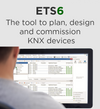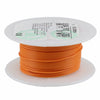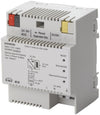- Your one stop shop for KNX devices in the USA 🇺🇸
- (+1) 786 956 6821
- support@knxsupply.com
- Store Location
- Sign in or Register
- Home
-
Categories
- System Devices
- Switching/Shutter Actuators
- Dimming Actuators
- HVAC
- Binary Inputs
- Keypads
- Gateways
- Enclosures and Boxes
- Occupancy Sensors
- Visualization Systems and Touch Panels
- Weather Sensors
- Drivers and ECGs
- Special Sensors
- HVAC
- Accessories
- Cable
- Expert Picks
- KNX Certified Training
- Newest Products
- Best Selling Products
Brands
- Articles
- Contact Us
- Home
- All Collections
- Binary/Analog Inputs
Binary/Analog Inputs
The MDT Analog In / Output AIO is suitable for controlling devices with 0-10 V input (e.g. ventilation systems) and for recording 0-20 mA (4-20 mA) / 0-10 V measurement data (e.g. from fill-level or pressure sensors).
Each channel can be configured both as an input and as an output and is galvanically separated from the KNX bus.
- 4 fold inputs. Can be individually configured per input
- 4 fold LED. Can be individually configured per LED
- LED output current: max. 2.5mA, limited via series resistor of 2K Ohm
- Input/Output wires: 2*5-pin wires, approx. 30cm. long. Can be extended up to 10 meters maximum
- Size: 1.81 x 1.81 x 0.46 inches. Fits in a 1-gang US wall box
The MDT Universal Interface BE, for example, makes conventional push-buttons, switches, window and auxiliary contacts “smart” for KNX.
The comprehensive application provides the suitable parameters for a wide range of applications.
Versions for floating contacts and 230 V AC are available.
The MDT Universal Interface BE, for example, makes conventional push-buttons, switches, window and auxiliary contacts “smart” for KNX.
The comprehensive application provides the suitable parameters for a wide range of applications.
Versions for floating contacts and 230 V AC are available.
The MDT Universal Interface BE, for example, makes conventional push-buttons, switches, window and auxiliary contacts “smart” for KNX.
The comprehensive application provides the suitable parameters for a wide range of applications.
Versions for floating contacts and 230 V AC are available.
The MDT Binary Input BE, for example, makes conventional push-buttons, switches, window and auxiliary contacts “smart” for KNX.
The comprehensive application provides the suitable parameters for various applications.
Versions for floating contacts, 24 V AC/DC and 230 V AC are available.
The MDT Binary Input BE, for example, makes conventional push-buttons, switches, window and auxiliary contacts “smart” for KNX.
The comprehensive application provides the suitable parameters for various applications.
Versions for floating contacts, 24 V AC/DC and 230 V AC are available.
The MDT Binary Input BE, for example, makes conventional push-buttons, switches, window and auxiliary contacts “smart” for KNX.
The comprehensive application provides the suitable parameters for various applications.
Versions for floating contacts, 24 V AC/DC and 230 V AC are available.
The MDT Binary Input BE, for example, makes conventional push-buttons, switches, window and auxiliary contacts “smart” for KNX.
The comprehensive application provides the suitable parameters for various applications.
Versions for floating contacts, 24 V AC/DC and 230 V AC are available.
The MDT Binary Input BE, for example, makes conventional push-buttons, switches, window and auxiliary contacts “smart” for KNX.
The comprehensive application provides the suitable parameters for various applications.
Versions for floating contacts, 24 V AC/DC and 230 V AC are available.
The MDT Binary Input BE, for example, makes conventional push-buttons, switches, window and auxiliary contacts “smart” for KNX.
The comprehensive application provides the suitable parameters for various applications.
Versions for floating contacts, 24 V AC/DC and 230 V AC are available.
The MDT Binary Input BE, for example, makes conventional push-buttons, switches, window and auxiliary contacts “smart” for KNX.
The comprehensive application provides the suitable parameters for various applications.
Versions for floating contacts, 24 V AC/DC and 230 V AC are available.
The MDT Analog In / Output AIO is suitable for controlling devices with 0-10 V input (e.g. ventilation systems) and for recording 0-20 mA (4-20 mA) / 0-10 V measurement data (e.g. from fill-level or pressure sensors).
Each channel can be configured both as an input and as an output and is galvanically separated from the KNX bus.
Blind/Shutter control with one output of a KNX Multi IO.
- The device may be used for permanent interior installations in dry locations or within distribution boards with DIN rail.
Bi-stable coupling relay for KNX Multi IO.
Application area
The Multi IO Extension Switch 590 serves as a power-saving alternative to commercial standard coupling relays.
The coupling relay is controlled as a mono-stable relay, but uses a bi-stable relay internally, thus reducing the holding current by up to 95%.
The Multi IO Extension Switch 590 has an integrated fuse to protect high-quality equipment.
- The push button interface is a binary input and output device for installation in in-wall boxes (Æ 60 mm, depth: 40 mm).
- Each of the two channels may be used either as an input for potential-free switch / push button contacts or as an output for control of a light emitting diode (LED).
- The required scanning / control voltage is provided by the push button interface (requires no additional power supply).
- For example, up to 2 switches/push buttons with one potential-free contact each or one 2-fold push button with two potential-free contacts may be connected to a push button interface.
- The connection is carried out via a cable set which is permanently connected to the push button interface.
- The connecting cables between switches/push buttons and the push button interface may be extended up to 10 m. It must be ensured that twisted cable pairs are used.
- Commands can be given to actuators via the connected switches/push buttons, e.g. for defined switching on/off, for dimming fluorescent lamps or for raising/lowering venetian blinds and adjusting the louvres.
- Each channel, which is configured as an output, can drive an output current of up to 2mA for controlling a light emitting diode (LED).
- With the ETS the application program is selected, its parameters and addresses are assigned appropriately, and downloaded to the push button interface.
- The DALI push-button input 4-fold flush-mounted 141/71 is a binary input device for insertion into a flush-mounted box.
- The device is powered via the connected DALI cable
- The device offers 4 input channels for potential-free contacts
- Installation switches or installation push-buttons can be connected. The required voltage is supplied by the DALI push-button input 4-fold (no additional voltage source required).
- Triggered by the connected push-buttons or switches, the DALI push-button input 4-fold sends telegrams via the DALI line to a central DALI controller.
Push button for extra low voltage for MATCH 55 series.
The 24V Push Button 436 is a push button for direct connection to push button inputs of e.g. smart home control panels, PLC controls or push button interfaces of any bus system.
The device is available with one or two rockers.
Each rocker offers two pressure points (up/down).
A pluggable connection cable is included in the scope of delivery.
The device is part of the MATCH 55 push button series.
With the supplied installation kit, the push button fits mechanically to numerous switch ranges available on the market with internal dimensions of 55 mm.
The push button is characterized by soft and quiet button press.
The optional terminal block enables the screwless connection of cables with a cross section of up to 0.75 mm².
KNX TP Push Button Interface with KNX Data Security.
Application area
The KNX TP Push Button Interface 420 secure is a push button interface for the KNX bus.
It is suitable as a binary input for connecting up to four conventional push buttons or potential-free contacts.
In addition, the device offers two outputs for LEDs.
A pluggable connection cable is included in the scope of delivery.
The integrated push buttons and LEDs allow a quick test of the configuration.
The application offers extensive functions for switching, dimming, shutter, valuator, scene and color control as well as sequence controllers and scalable pulse counters.
Each channel can be configured individually.
The flexible operating concept also allows different functions on one channel depending on the setting.
In addition, the device contains 10 independent logic or time functions.
The device supports KNX Data Security.
KNX IP Multi IO with 48 configurable In- and Outputs.
Application area
The KNX IP Multi IO 580 is a universal binary interface for building control.
It provides 48 I/O lines.
Each line can be used as binary input as well as binary output.
The peripherals can be fed by an external voltage of 24 V⎓.
Channels which are configured as inputs can be used to control lights or blinds via the KNX network.
They also can be used to count impulses, e.g. as interface for energy meters.
Channels which are configured as outputs can directly drive signal LEDs, external coupling relays (e.g.
590) or jalousie relays (592).
The device works using the medium KNX IP.
It can be configured using the ETS (Version 4.2 or higher) with native parameters and standard group objects.
Also the KNX addressing scheme, based on individual device
address and group objects, is unchanged.
An easy to read OLED display on the front panel enables a manual operation to test the installation.










































